Imagine that you have been assigned an on-location photoshoot. You arrive and meet your client. Handshakes and smiles all round. Now, it's time to work your magic.
You find your flimsy camera bag and fish out the camera body from its depths. You also find a lens in there somewhere. Then, you realise you need to set white balance, so you start unzipping one pouch after another to find the grey cards as your client looks on. Then it starts to rain. Your bag is getting wet and supposedly it's "water-resistant", but the question is: just how much water will it resist? Finally, to top it all off, someone trips over it, and you cringe and hope that all those soft walls absorb some of the impact from your expensive camera gear.
This is why I don't use soft-padded camera bags, especially the cheap ones. When I'm on-location, I need to know that my gear is safe and organized. When I say "safe", I don't mean "cushioned". I mean, hopefully, indestructible. When I say "organized", I want to be able to see it and reach everything at once without having to rummage through pockets and pouches. This is where the Pelican 1510SC case comes in.
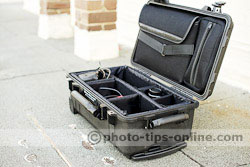 |
Pelican, in the wold of camera cases, holds the same spot as the Abrams tank does on the battlefield. You can probably damage it by shooting a cannon into it, but even then, it would probably want to finish the assignment angry and damaged, rather than limp home and sulk.
It is water-proof, heat-proof, and it is designed in a way which distributes the force of impact along the sides of its body, rather than transferring it directly into its content. This not only means that your camera gear is protected but also that the case's common weak points — joints, hinges, and wheels — are not likely to bust if you drop it.
You can order the Pelican 1510 in a number of internal configurations to suit your needs. Mine is the "SC" version, which comes with adjustable internal padded dividers and a 15" laptop sleeve. It means that my entire studio setup can travel with me and, if I want to show a client proofs on a computer screen before leaving location, I can.
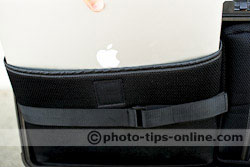 |
I typically pack pretty light — 1-2 camera bodies and 2 lenses plus bits and pieces. Photographers who carry more gear will be fine as well: the case can easily fit 2-3 camera bodies, 4-6 lenses, a few off-camera flashes, and all the loose stuff.
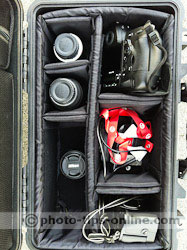 |
As you might have noticed already, I'm a huge fan of being able to use everything I have at my disposal in one glance. That's why I like the dividers.
You can also order your case with a slab of foam (which you have to cut to your needs) instead of the dividers, but I think that option is more useful for people with unique and specialised equipment, but for photographers, the dividers is a better idea.
A downside of this kind of case versus a modern camera bag is that you can't strap it to your back or hang it over your shoulder. It's strictly a "pick me up, carry me over there, and put me down" kind of contraption. The other downside is that you can't strap a tripod to it, like you can do with many camera bags.
Take this into account: all that protection does come with a price, which makes the case heavier than a padded bag. It's not unreasonably heavy, but it's not insignificant, either.
I lugged mine across 5 city blocks the other day and I knew about it. If you have a lot of gear, you'll definitely know about it. The good thing is that it has wheels and a slide-out handle, so you can drag the whole thing along with relatively little effort.
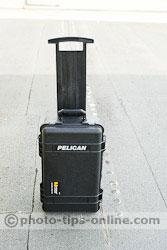 |
The only complaint I have about the wheels is that they're so hard (a side-effect of making them uber-tough, I presume) that they don't absorb any road surface undulations. It means that on anything but smoothest asphalt the case makes more noise than the above mentioned Abrams tank. Pensioners jump out of your way in fear.
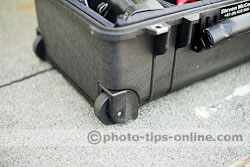 |
The case is also just under the standard FAA size limit for carry-on luggage, so if you travel by airplane, you don't have to check it in and wonder what the baggage handlers are doing to it. Having said that, it has metal-padded lugs which will accept very decent sized padlocks, so if you do have to check it in, it gives you an added piece of mind.
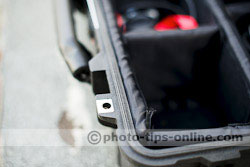 |
You can have an option to label your case with a personalised nameplate that includes your phone number or email address, which I think is a nice touch. Even though I doubt that if stolen, the case will be returned, it feels like it's another (albeit small) layer of risk reduction, which adds to the effectiveness of the whole package.
The Pelican 1510SC is not strictly photo equipment, but it is arguably just as important to a travelling professional photographer as his camera. It's not just a box. It's a system for protecting, organising, and transporting your photo equipment. It doesn't require maintenance and it does its job effortlessly. In fact, I tend to take mine for granted, which is a sign that it's a little bit too good at its job. And for me it means I'm free to pay utmost attention to my subjects, instead of having to worry about my gear.
 |
Guest writer: Steven McConnell Steven McConnell is a family portrait photographer based in Sydney. He is passionate about creating candid lifestyle portraiture of kids and their parents which communicates who they are as people and the love that flows in their family. You can catch up with him on Twitter and Google + |